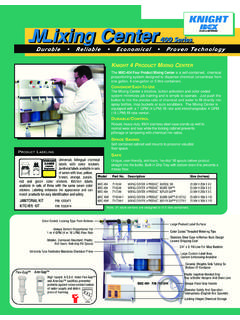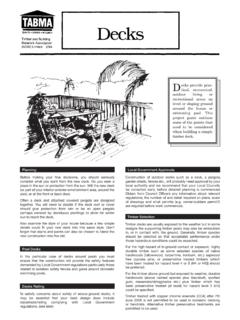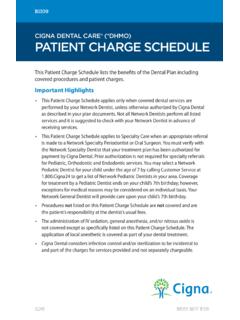Transcription of Economical and Ecological Comparison of …
1 Economical and Ecological Comparison of transport Modes: Road, Railways, Inland Waterways Summary of Findings PLANCO Consulting GmbH, Essen Lilienstr. 44, D-45133 Essen Tel. +49-(0)201-43771-0; Fax +49-(0)201-411468. e-mail: in co-operation with Bundesanstalt f r Gew sserkunde Am Mainzer Tor 1, D-56068 Koblenz Tel. +49-(0)261-1306-0; Fax + 49-(0)261-1306-5302. e-mail: November 2007. Study prepared on behalf of the Federal German Water and Shipping Administration represented by the Water and Shipping Directorate East Economical and Ecological Comparison of transport Modes Road, Railways, Inland Waterways Summary of Findings page I. Content 1 Introduction 1. 2 Infrastructure Networks 1. Current Infrastructure Networks, Their Quality, Investments and Costs 1. Capacity Utilisation of Infrastructure 3. 3 Taxation 8. 4 transport Volumes and Forecasts 8. 5 Energy consumption 11. 6 External Cost 14. transport Safety 14. Traffic Noise 15.
2 Climate Gases 17. Air Pollution 18. Landscape Dissection and Area Consumption 21. Summary of External Costs 22. 7 transport Costs 25. Economies of Scale 25. Cost Comparisons for Selected Routes 31. 8 Specific Aspects of Inland Shipping 38. Multiple Use of Waterways 38. Climate Change and Flood Protection 39. Essen, November 2007. Economical and Ecological Comparison of transport Modes Road, Railways, Inland Waterways Summary of Findings page II. List of Tables Table 1: Reserve Capacities of Inland Waterway Locks in 2015 for the Major transport Direction (million tonnes ) 7. Table 2: Development of Freight transport Performance of Inland Shipping in Germany, 1997 to 2015 9. Table 3: Selected Routes for Comparative Analysis of transport Costs 31. Table 4: Types of Vessels or Vessel Combinations and Return Freight Assumptions for Selected Shipping Routes 33. List of Figures Figure 1: Total Length of transport Networks in Germany (2004) 1.
3 Figure 2: Gross Value of Infrastructure Networks of Waterways, Railways and Federal Roads in 2004, by Years of Investments 2. Figure 3: Intensity of Traffic Disturbances for Trucks on German Highways in 2005 4. Figure 4: Traffic Load and Capacity Utilisation of the German Railway Network in 2015 According to BVWP 2003 (Reference Case without New Investments) 6. Figure 5: Modal Shares in Seaport Hinterland transport 2004 10. Figure 6: Spread and Averages of Primary Energy Consumption on Selected transport Relations 13. Figure 7: Total and Unit Economic Costs of Accidents in Freight transport on Road, Rail and Inland Waterways 15. Figure 8: Average External Costs of Traffic Noise 16. Figure 9: Spread and Averages of External Costs of Climate Gas (CO2) for Selected transport Routes 18. Figure 10: Development of Exhaust Emission Factors in Inland Shipping with the Fleet Structures of 2006 resp. 2025 19. Figure 11: Spread and Average Values of External Costs of Air Pollution (NOx, NMHC, particles, CO, SO2) for Selected Routes (OD pairs) in 2006 20.
4 Figure 12: Spread and Average Values of External Costs of Air Pollution (NOx, NMHC, particles, CO, SO2) for Selected Routes in 2025 21. Essen, November 2007. Economical and Ecological Comparison of transport Modes Road, Railways, Inland Waterways Summary of Findings page III. Figure 13: Spread and Average Values of All External Costs (Noise, Accidents, Climate gases, Air Pollution) for Bulk Freight on Selected Routes 23. Figure 14: Spread and Average Values of All External Costs (Noise, Accidents, Climate gases, Air Pollution) for Container Freight on Selected Routes 24. Figure 15: transport Cost by Road Depending on the Freight Volume 26. Figure 16: transport Prices for Full Wagon Load of the Railion AG Depending on the Freight Weight 27. Figure 17: Unit transport Cost per ton-km on Railways of Block Trains As a Function of the Freight Volume per Train 28. Figure 18: Degression of Unit Costs per ton-km According to Effective Draft for a Big Motor Vessel 29.
5 Figure 19: transport Unit Costs for Selected Vessel Types at Different Levels of Effective Vessel Draft 30. Figure 20: Financial transport Cost of transport Modes for Selected Bulk Freight Routes 34. Figure 21: Financial transport Cost for Selected Container Routes, by Modes of transport 35. Figure 22: Economic Cost for Bulk Cargo transport on Selected Routes, by transport Modes (incl. external cost of noise, accidents, climate gas emission and air pollution) 36. Figure 23: Economic Cost of Container transport on Selected Routes, by transport Modes (incl. external cost of noise, accidents, climate gas emission and air pollution) 37. Essen, November 2007. Economical and Ecological Comparison of transport Modes Road, Railways, Inland Waterways Summary of Findings page 1. 1 Introduction Available studies and publications comparing the transport modes under the perspective of transport economics and of ecology are generally neither comprehensive nor sufficiently differentiated regarding the system of inland shipping and waterways.
6 Due to unrealistic assumptions the relative position of inland shipping is not assessed adequately. Based on an initiative of the Association of European Inland Shipping and Waterways (Verein f r eu- rop ische Binnenschifffahrt und Wasserstra en VBW) the German Federal Water and Shipping Administration (WSV), represented by the Water and Shipping Directorate East, has commissioned this study. The aim of the study is to present an up-to-date Comparison of transport modes which is sufficiently differentiated and substantiated. Main results are presented in this summary. 2 Infrastructure Networks A high-quality transport infrastructure is conditional to a well functioning economy and so- ciety. It determines the competitiveness of production locations, the quality of life and gen- eral well-being. Current Infrastructure Networks, Their Quality, Investments and Costs The total length of inland waterways is significantly smaller than that of roads or railways.
7 The length of the railway network is five times that of inland waterways. The factor for long- distance roads (federal highways and roads only) is more than seven. Figure 1: Total Length of transport Networks in Germany (2004). Waterways Railways Long-distance (federal) roads For all three modal networks new sections were added in past decades, and existing sec- tions have been improved. In the period 1991 to 2004, the total length of the inland water- Essen, November 2007. Economical and Ecological Comparison of transport Modes Road, Railways, Inland Waterways Summary of Findings page 2. ways with international significance (waterway classes IV and higher) was extended to km (by 340 km). To a similar extent, the length of lower-class waterways was re- duced. The quality of the railway network benefited from additional lanes and progressing electrifi- cation. The long-distance road network was improved by introducing both further sections and additional lanes.
8 Total gross investments into waterways were not only far lower than for roads and rail- ways, but also developed at lower growth rates: While the total growth of investments in the period 1991 to 2004 was + for waterways (coastal and inland), it was + for railways and + for long-distance roads. As a consequence the age structure of wa- terways is clearly less favourable than of railways and roads. There is a risk that this qual- ity disadvantage impacts intermodal competition to the disadvantage of waterways. Where this quality disadvantage affects operational safety, negative consequences for waterways transport can be significant: While road transport can often shift to other routes, such alter- natives are usually not available for waterways. Figure 2: Gross Value of Infrastructure Networks of Waterways, Railways and Federal Roads in 2004, by Years of Investments to to to to Federal Roads Railways Waterways By confronting the expenditure with the respective revenues for the use of federal roads, railways and waterways, the degree of cost recovery can be shown.
9 These figures give an indication on the implementation of the user-pays principle. But they do not allow to assess the Economical profitability. Detailed calculations for the year 1987 for freight transport Essen, November 2007. Economical and Ecological Comparison of transport Modes Road, Railways, Inland Waterways Summary of Findings page 3. show that for all three inland modes only part of the infrastructure cost is recovered. The value of unrecovered costs, per 1,000 ton-km, was for inland shipping. This is sig- nificantly better than for rail transport ( ). Percentage-wise, road freight transport had the highest cost recovery ratio in 1987. ( ). For railways and waterways, respective ratios were and More recent figures are not available. It is to be assumed that the cost recovery ratio for road freight has further improved due to the step-wise increase of fuel taxes (as part of Ecological taxa- tion) and due to the introduction of a truck toll on highways.
10 In this context it is important to note that, different from other modes, waterways have significant non- transport -related functions and benefits. Furthermore, infrastructure costs represent only a fraction of total social costs which are more relevant for defining optimum user charges which achieve the highest social welfare. To give an example: The social costs of road accidents alone in Germany clearly exceed total infrastructure costs of inland waterways. Capacity Utilisation of Infrastructure Over past thirty years, both passenger and freight transport increased significantly in Ger- many. Traffic volumes on federal roads experienced the highest growth rates. Forecasts prepared for the Federal transport Infrastructure Plan of 2003 (BVWP 2003) show a clear further growth of traffic volumes. Therefore, the issue becomes ever more important, whether and to which extent the different transport modes can absorb additional traffic loads.







